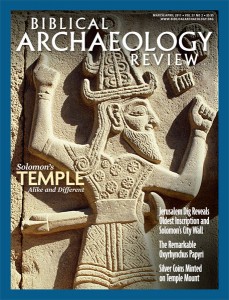Strata: Revisiting Forgeries Through Old Photographs

Sometimes a picture is worth a thousand words, or at least a couple hundred.
The streets of 1870s Jerusalem were abuzz with news of the fantastic ancient objects being sold by Moses Shapira in his Christian Quarter Road antiquities shop. Since 1868, when the famous Mesha Stela (or Moabite Stone) was discovered in the land of Moab across the Jordan,a Shapira’s shelves had been lined with hundreds of stone and clay figurines and vessels, including those pictured in this 1874 photograph, purportedly crafted by the Biblical Moabites.
At the time, the objects, many of which include stylized faces and raised lettering resembling the script of the Mesha Stela, were accepted by most, including many respected European scholars, as genuine cultic vessels of the lost Moabite civilization. Shapira claimed that some of the figures even depicted the kings of Israel and Judah. For the public and Bible scholars alike, the vessels—along with the Mesha Stela—were tangible proof of the Bible’s historical reliability at a time when the Bible was increasingly scrutinized and questioned by critical Biblical scholarship, especially in Germany. Major European institutions, including the Berlin Museum, paid Shapira thousands to acquire the vessels for their collections.
Already a library member? Log in here.
Institution user? Log in with your IP address.

